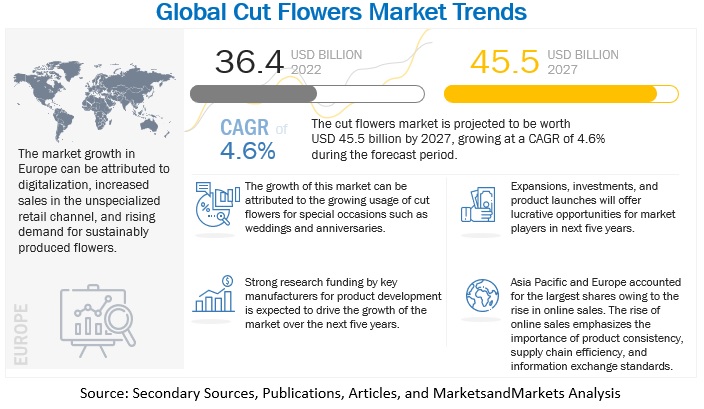The global cut flowers market size is estimated to be valued at USD 36.4 billion in 2022. It is projected to reach USD 45.5 billion by 2027, recording a CAGR of 4.6% during the forecast period. Flowers have had an important place in history, culture, and decoration since ancient times. Cut flowers are stem and bud cuttings of ornamental plants that are used for floral decorations, wreaths, packaging, bouquets, and much more. The cut flowers market involves the breeding, growing, harvesting, arranging, and selling of cut flowers as they are or as end products with definite arrangements. Cut flowers are a major business for the floriculture industry. Globally, cut flowers are recognized as the most commercially produced ornamental.

Cut flowers are mostly used for gifting on special occasions like birthdays, Valentine’s Day, weddings, anniversaries, and Mother’s Day. Show usage trends of cut flowers. Apart from gifting, cut flowers are widely used in floral and art arrangements in festivals, celebrations, mourning as well as proposals. Several commercial and home spaces use flowers for aesthetics, enhancing the décor as well as creating a positive conducive environment. Some commercial setups that regularly use cut flowers are offices, hotels, spas, and restaurants.
Here are some of the trends of cut flowers market:
1. Sustainability: There has been a growing demand for sustainably sourced and grown flowers. Consumers are increasingly conscious of the environmental impact of their purchases, leading to a rise in the popularity of locally grown, organic, and eco-friendly flowers. This trend may lead to increased interest in flower varieties that require fewer resources to grow or are grown using sustainable practices.
2. Online Sales: The online retailing of flowers has seen significant growth, especially with the rise of e-commerce platforms and the convenience they offer. Online florists often provide a wider selection of flowers, allowing consumers to access exotic or rare varieties that may not be available at local flower shops. Additionally, online platforms offer convenient delivery options, making it easier for consumers to purchase flowers for various occasions.
3. Premium and Specialty Flowers: There’s a growing demand for premium and specialty flowers, including exotic varieties, unique hybrids, and rare blooms. These flowers often command higher prices and cater to consumers seeking distinctive floral arrangements for special events or gifts.
4. Seasonal Variability: Weather patterns and climate change can significantly impact flower production and availability. Extreme weather events, such as droughts, floods, or heatwaves, can disrupt flower supply chains, leading to fluctuations in prices and availability. Producers may need to adapt their growing practices or invest in technologies to mitigate the effects of climate change on flower cultivation.
5. Health and Wellness Trends: Flowers are increasingly recognized for their therapeutic and wellness benefits. There’s growing interest in using flowers for aromatherapy, home decoration, and as gifts to promote emotional well-being. This trend may drive the demand for specific types of flowers known for their aromatic properties or symbolism in traditional medicine.
6. Wedding and Event Industry: The wedding and event industry plays a significant role in driving demand for cut flowers, particularly for large-scale events such as weddings, corporate gatherings, and parties. Trends in event styling and décor influence the types of flowers chosen, with preferences shifting between classic, romantic arrangements and more modern, minimalist designs.
7. Global Supply Chains: The cut flowers market is highly globalized, with flowers being grown in various countries and regions and transported internationally. Factors such as trade policies, currency fluctuations, and transportation costs can impact the prices and availability of cut flowers in different markets. Changes in global trade dynamics or disruptions to supply chains (e.g., due to pandemics or geopolitical tensions) can affect the supply and pricing of cut flowers.
Cut Flowers Market Opportunities: Increasing use of cut flowers in accessories and decorations
Orchid flowers are widely used in Thailand, Singapore, and Malaysia to electroplate with gold and platinum to make exquisite jewelry. India has enormous potential with orchid species and hybrids like Dendrobium, Phalaenopsis, Cattleya, Oncidium, Arnada, Mokara, Vanda, and Pholidota. To diversify into such avenues to exploit the vast genetic resources and expert craftsmanship available in the country. Cut flowers are used as home accessories known as Potpourri. Potpourri is a mixture of dried, naturally fragrant plant material that provides a gentle natural scent in houses. It is usually placed in a decorative wooden bowl or tied in small bags made from sheer fabric. Dried flowers are used as a common component of potpourris. Rose petals, gomphrena, marigold petals, and lotus pods are ideal for making potpourris.
Flowers are a natural source of bioactive compounds that not only have antioxidant, anti-infammatory, and anti-aging properties but can also be used as natural dyes. Based on the current market trends, more consumers are looking for natural products, which, in their opinion, are safer and more effective. For that reason, producers are forced to look for natural replacements for synthetically derived substances to prepare products that meet the requirements of consumers.
Researchers from Poland have investigated the use of plant extracts in cosmetics, looking at active properties and the potential use of flower extracts as dyes. Studies revealed that common poppy, safflower, and blue pea could be used as effective colorants in cosmetic products. Moreover, plants do not show any cytotoxic activity. This may indicate that these plants can be used in cosmetics to slow down the aging process, such as anti-aging creams and moisturizers.
Download PDF Brochure: https://www.marketsandmarkets.com/pdfdownloadNew.asp?id=18187231
Carnation is projected to grow in the cut flowers market because of usage in weddings
Dianthus caryophyllus, also known as carnations, is a species of Dianthus. It is native to the Mediterranean region, with characteristic fringe petals and a spicy fragrance. Carnation is a very popular cut flower and is widely used in floral arrangements, corsages, and boutonnieres. Carnations symbolically mean good luck, love, and gratitude. Cultures around the world use red and pink carnations.
In France, purple carnations are used in funerals, while in the US and Korea, carnations are an important part of proms and weddings. Carnation flowers come in several hues and offer many floral decorations. They offer great versatility and flexibility in their usage. They are widely used as a base for floral arrangements, and other blooms are added to create an aesthetic centerpiece. Europe and Western Asia are the largest growers of carnations globally. The world’s biggest carnation supplier is Colombia. Some major companies growing carnations are Flamingo, Esmeralda Farms, and Danziger.
Europe dominated the cut flowers market; it is projected to grow at a CAGR of 4.1% during the forecast period.
According to the Centre for the Promotion of Imports from developing countries, annually, the European Union is believed to consume over 50% of the world’s flowers and includes many countries with a high per capita consumption of cut flowers. Although some of the larger EU markets like Germany, France, and the Netherlands show signs of saturation, overall EU consumer sales of cut flowers are still increasing incessantly. Germany is the biggest consumer of flowers, followed by the UK, France, and Italy.
The most important cut flower sold in Europe is Rosa, followed by other flowers like Dendranthema (Chrysanthemum), Dianthus (Carnation), Tulipa, Lilium, and Gerbera. Growers and traders exporting cut flowers and foliage to the EU send their merchandise either to a wholesaler or to an auction. In this respect, Dutch auctions play a pivotal role in the trade of flowers destined for domestic and European markets. Products handled by agents and import wholesalers are sold directly to a wholesale buyer or submitted for auction. Export wholesalers re-export the products to other EU member countries, where flowers and foliage find their way to wholesalers and retailers.
Top Companies in the Cut Flowers Market
The global cut flowers market is dominated by top players such as Dummen Orange (Netherlands), Danziger Group (Israel), Dos Gringos LLC. (US), Esmeralda Farms (US), Flamingo (UK), Florance Flora (India), Karen Roses Company (Kenya), Marginpar BV (Netherlands), Multiflora (US), Rosebud Limited (Uganda), Selecta One (Germany), Washington Bulb Co., Inc. (US), Soex Flora (India), and Florius Flowers (UAE).
Danziger Group is a leading player in the cut flowers market and one of the leading floriculture innovation companies. The company engages in research, development, breeding, sales, and marketing of high-quality cut flowers. It produces perennials and annual flowers for all parts of the supply chain. The company is present globally, with 500 million cuttings of Danziger varieties planted each year in 60 countries. It also has 600 elite varieties of superior-quality flowers that have superior genetics. Danziger Group has high-end production facilities that span over 70 hectares of open fields and 15 hectares of state-of-the-art greenhouses. Danziger Group’s flower varieties are registered under Plant Breeding Rights (PBR) and Plant Patents worldwide. The company supplies cuttings, plants, and in vitro through an efficient cold chain distribution network. Danziger Group prides itself on imaginative, high-quality, and robust varieties of flowers. The company’s product portfolio includes cut flowers, annuals, perennials, ThinkPlants, and Durabella. Some of its well-known cut flowers are roses, chrysanthemums, carnations, gypsophila, and anemones. The Danziger Group has four brands under its name: Danziger seeds, Danziger seeds, Beauty Line, and Equinom. It sells cut flowers under its Beauty Line Brand
Dummen Orange is an ornamental breeding floriculture company. It is a platform where all breeders are represented under one brand, and the company assists them with modern and traditional technologies to produce high-quality ornamental plants. The company specializes in breeding, producing, and marketing bedding plants, potted plants, cut flowers, and perennials. Dummen Orange has a strong global network and operates primarily in Europe, the Middle East, Africa, and Asia Pacific. Under its cut flowers range, the company currently sells Gerbera, Carnations, Chrysanthemum Roses, Limonium, and Mum Africa. Dummen Orange has market access to some of the fastest-growing and most profitable regions of the world, including South America and Asia Pacific, which have some of the fastest-growing economies, such as Brazil, India, and China. It also has a presence in the North American and European markets, which are significant for the cut flowers market. The company has a wide portfolio of seasonal and all-year-round flowers in multiple categories. This helps it cover the entire value chain, which further helps it understand the challenges at various stages of the value chain and address them.
Get 10% Free Customization on this Report: https://www.marketsandmarkets.com/requestCustomizationNew.asp?id=18187231
About MarketsandMarkets™
MarketsandMarketsTM has been recognized as one of America’s best management consulting firms by Forbes, as per their recent report.
MarketsandMarkets™ is a blue ocean alternative in growth consulting and program management, leveraging a man-machine offering to drive supernormal growth for progressive organizations in the B2B space. We have the widest lens on emerging technologies, making us proficient in co-creating supernormal growth for clients.
Earlier this year, we made a formal transformation into one of America’s best management consulting firms as per a survey conducted by Forbes.
The B2B economy is witnessing the emergence of $25 trillion of new revenue streams that are substituting existing revenue streams in this decade alone. We work with clients on growth programs, helping them monetize this $25 trillion opportunity through our service lines – TAM Expansion, Go-to-Market (GTM) Strategy to Execution, Market Share Gain, Account Enablement, and Thought Leadership Marketing.
Built on the ‘GIVE Growth’ principle, we work with several Forbes Global 2000 B2B companies – helping them stay relevant in a disruptive ecosystem. Our insights and strategies are molded by our industry experts, cutting-edge AI-powered Market Intelligence Cloud, and years of research. The KnowledgeStore™ (our Market Intelligence Cloud) integrates our research, facilitates an analysis of interconnections through a set of applications, helping clients look at the entire ecosystem and understand the revenue shifts happening in their industry.
Media Contact
Company Name: MarketsandMarkets™ Research Private Ltd.
Contact Person: Mr. Aashish Mehra
Email: Send Email
Phone: 18886006441
Address:630 Dundee Road Suite 430
City: Northbrook
State: IL 60062
Country: United States
Website: https://www.marketsandmarkets.com/Market-Reports/cut-flowers-market-18187231.html

